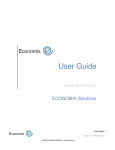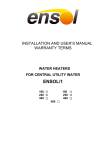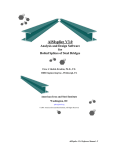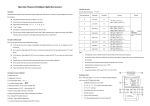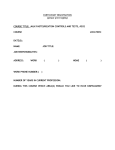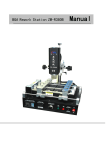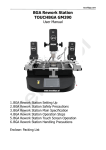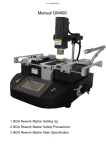Download HEATER type EJK
Transcript
HEATER type EJK with insulated heating elements for water heaters 3 ~ 400 V EJK- 3000 □ EJK- 4500 □ EJK- 6000 □ EJK- 9000 □ INSTALLATION AND USER MANUAL WARRANTY CONDITIONS Before installation please read carefully the following Installation and User Manual as well as the Warranty Conditions. Table of Contents: 1. General information ………………………………………………… 3 2. Structure and technical data ………………………………………... 3 3. Heater installation ………………………………………………........ 5 3.1 Assembly in tank ………………………………………........…....... 5 3.2 Electrical connections …………………………............................… 6 4. Turning on and water temperature setting ……………………......... 9 5. Overheating protection …………………………….....................…. 10 6. Anti-freeze protection …………………………….......................…. 10 7. Operating instructions ……………………………......…………….. 10 8. Warranty conditions ……………………………………………….... 13 ATTENTION! 1. Dry operation (without water) should be strictly avoided. Place the plug in the socket only after the tank has been filled with water. Otherwise heating elements may become overheated and damaged, and therefore will require replacement. 2. The plug must be accessible after the heater is installed. 3. If the power cord is damaged, it should be replaced by the manufacturer or by a specialized repair shop, or by a qualified person in order to avoid risks. The heater and the metal tank must be connected with a protective conductor led from the marked terminal on the heater casing. 2 1. General information Heaters type EJK are designed for heating water in open and closed metal tanks, including enamelled domestic hot water tanks in particular. In those tanks with anti-corrosion cathodic protection system using magnesium anode or external current anode heating elements should be partially insulated electrically from tank walls. Thanks to this, the electrochemical potential difference between heating elements made of copper or special stainless steel and the tank made of carbon steel is partially equalized in a tank filled with water. This way the durability of heating elements and the life of the magnesium anode are increased significantly. The insulation of heating elements in EJK heaters is done by fixing them in a casing wholly made of plastic, including the threaded part. A grounding resistor of a suitable resistance is used for a partial connection of heating elements with the tank. The resistor incorporates these elements in the tank anti-corrosion cathodic protection system. This is an optimum solution to protect the electric heater inside the enamelled tank from an accelerated electrochemical corrosion, maintaining the tank cathodic protection and the magnesium anode life. 2. Structure and technical data Heaters type EJK are made of tubular heating elements with an internal resistance wire and a casing containing a three phase 400V power unit, including a temperature controller with stepless temperature adjustment and a non-automatic temperature limiter to protect the heater from overheating. The temperature controller knob and signal lamps are situated in the cover closing the upper part of the casing body. The lower part of casing body ends with a head with a hexagonal socket for an S-60 wrench and a 1½” thread to screw the heater to the tank coupling. If the hexagonal wrench socket is not accessible, the heater can be screwed in similarly to a car oil filter for example, that is, by holding it by the casing which is made of a durable, heatresistant plastic. Heaters structure scheme and their technical data are shown in fig. 1 and in table 1. 3 1 - casing body 2 - cover 3 - heating element 4 - temperature controller knob 5 - gland 6 - signal lamps 7 - power cord 8 - plug for STB connection 9 - grounding conductor 10 - capillary sensor protective tube 11 - gasket Fig. 1. Heater structure Tab. 1. Heaters technical data Power Supply voltage Dead zone length Immersion depth to the gasket Threaded connection Minimum tank volume [kW] [V] [mm] [mm] [inch] [dm³] 3.0 4.5 6.0 9.0 3 ~ 400 3 ~ 400 3 ~ 400 3 ~ 400 100 100 100 100 290 390 500 720 1 ½” 1 ½” 1 ½” 1 ½” 80 100 100 250 Heater type EJK EJK EJK EJK - 3000 4500 6000 9000 4 3. Heater Installation 3.1 Assembly in tank A. Type of tank The tank and its connections must be made of metal. Both the tank and all its other metal parts which are in contact with water must be connected with the protective conductor in a permanent and reliable way. B. Working position During operation heating elements and the sensor protection must be totally immersed in water and free thermally forced water circulation must be ensured. The length of the coupling for assembling the heater shall not exceed circa 100 mm so that it does not stand out from the heating elements dead zone (unheated zone). The heater may only operate in horizontal or semi horizontal position. Heater casing must not be covered nor thermally insulated as it would disturb normal operation of the temperature controller and of the temperature limiter installed in the casing. When assembling the heater make sure that heating elements length fits into the tank and that they do not touch any internal parts of the tank, such as heat exchangers or thermometric pipes. C. Pressure tanks The heater is adapted for installation in pressure tanks of an admissible pressure not higher than 10 bar. All the assembly, installation and service conditions for these tanks (boilers) must be observed. It is also absolutely obligatory to install a safety valve with the opening pressure not higher than indicated in the tank operating parameters. Valve flow capacity should be chosen taking into account the power of all heaters and heat exchangers which heat water in tank, as regulated by the Office of Technical Inspection, using the technical data published by particular safety valves manufacturers. Safety valve opening pressure when heater type EJK is used must not exceed 10 bar. When installing an electric heater in a pressure tank it must be also remembered that the operation of these devices is subject to various kinds of technical inspection, particularly in accordance with the EU Pressure Equipment Directive 97/23/EC. Among other things, it stipulates that: 1. Electric storage water heaters for domestic water of working temperature not higher than 100ºC and capacity not larger than 300 l as well as tanks filled with water (heat exchangers included) of working temperature not higher than 100ºC and capacity not larger than 500 l are subject to simplified inspection, and therefore do not need to be reported to the Office of Technical Inspection. 5 2. Electric water heaters of capacity larger than 300 l as well as tanks filled with water (heat exchangers included) of capacity larger than 500 l are subject to limited inspection and need to be reported to the Office of Technical Inspection. D. Heater sealing Seal the heater only with a flat gasket Ø 60 x Ø 48 mm (plane faying surface on the heater head) or with an O-ring gasket Ø 46 mm x 5 mm (grooved faying surface on heater head). As en exception, Teflon tape may eventually be used. Make sure that the thread of the plastic head is not damaged when the heater is screwed in. 3.2. Electrical connections The heater should be connected by a properly qualified person in co-ordination with the local electricity provider. A. Heater power supply Three phase current heaters with power of 3.0 kW, 4.5 kW, 6.0 kW and 9.0 kW are provided by the manufacturer with 1.5 m long, four-wire power cords without plug. The free end of this cord should be connected to three phase installation at the user's using a four pin plug and a proper socket or a switch to ensure a proper disconnection on all poles for III category overvoltage conditions. If it results necessary to lengthen the power cord, use a cord with wire section not less than shown in table 2. Tab. 2. Minimum wire section of power cord Heater type EJK-3000 EJK-4500 EJK-6000 EJK-9000 Power Rated current Minimum wire section of power cord [kW] [A] [mm2 ] 3.0 4.5 6.0 9.0 4.3 6.5 8.7 13.0 1.0 1.0 1.5 1.5 6 Type of gland in heater casing Power cord diameter [mm] PG 13.5 PG 13.5 PG 13.5 PG 13.5 6.0 ÷ 12.0 6.0 ÷ 12.0 6.0 ÷ 12.0 6.0 ÷ 12.0 B. Tank and heater grounding The free end of the yellow and green protective conductor led from the marked terminal on the heater casing must be obligatorily connected to the metal tank in which the heater is assembled. If the yellow and green conductor provided by the manufacturer results too short replace it with a longer one to provide a good electric contact both on the tank and the terminal on the heater casing. C. Electrical installation diagram 1 - heating element 2 - temperature controller + temperature limiter 3 - resistor LS1 - green signal lamp LS2 - red signal lamp Fig. 2. Electrical installation diagram of three phase current 400V electric heater The plug or the switch must be accessible after the heater is installed. 4. Turning on and water temperature setting After the power is turned on (the plug is placed in the socket), both signal lamps situated on the casing cover should light up: - green lamp, which shows that power is on, - red lamp, which shows the passage of current through the heating element. If the temperature controller knob is in its extreme left position and the red lamp does not light up, turn the knob to the right until the contacts in the temperature controller close. It is recommended to supervise the first heating of water, remembering that during heating process the volume of water in pressure tank expands and it must be evacuated through the safety valve or accumulated in a diaphragm expansion vessel. The heater power is cyclically turned on and off by the temperature controller as hot water cools down or is consumed. The temperature controller cooperates with the capillary sensor placed in a special protective 7 pipe, immersed in water. By turning the temperature controller knob (tab. 4) the desired temperature in water tank can be set steplessly up to +70 0C maximum (turn the knob all the way to the right). When the set temperature is achieved, temperature controller shall automatically turn off the power supply to heating elements and shall turn it on again when water temperature drops below the set temperature. 5. Overheating protection The heater is protected against overheating by a non-automatic temperature limiter, the so-called STB, which cuts off the current flow to the heating unit in case of failure of the temperature controller and a temperature rise over 900C. Power can be turned on again only after the heater cools down and the button situated on the temperature limiter body is pressed. To do so, remove the hole plug 8 (fig. 1) situated in the heater casing cover, and then press the button using a small screwdriver for example (unplug the device first). This operation shall be carried out only by a properly qualified person, who will define the cause of the failure and remove it. 6. Anti-freeze protection The temperature controller used in the heater is provided with an antifreeze protection feature to maintain the temperature of water in tank in the level of +50C. This feature can be turned on by turning the temperature controller knob all the way to the left. The heater is not turned off in this position, it is anti-freeze protection only. 7. Operating instructions A. Heaters type EJK do not need to be supervised during operation. However, if the water is hard, heating elements should be periodically cleaned of boiler scale as it blocks the heat flow and therefore increases the current consumption and may cause damages of heating elements. B. The temperature of water in tank is set by the temperature controller knob. Remember that electric energy consumption and accumulation of boiler scale increase at higher temperatures. Temperatures of water achieved for various settings during tests at the manufacturer's are shown in tab. 3. 8 Tab. 3 Water temperature for various settings of temperature control knob Three phase heater (3 ~ 400 V) Description In its extreme left position the temperature controller operates as an anti-freeze protection feature, that is, it turns the heater on only after the temperature drops down to +5oC. Ca.+30oC, lukewarm water, directly suitable for washing in a washbasin, no accumulation of boiler scale Ca.+50oC, moderately hot water, slight accumulation of boiler scale Ca.+70oC, hot water, high accumulation of boiler scale . 9 8. Warranty Conditions 1. Warranty is granted for a period of 24 months. 2. Warranty period starts on the day of sale of the product to the user, which is inscribed in the warranty card and confirmed by a proof of purchase (invoice) issued by the seller. 3. The warrantor ensures a proper functioning of the heater under the condition that it is installed and used as described in the present manual. 4. Heating elements damaged due to excessive accumulation of boiler scale are not covered by the warranty. 5. During the warranty period the user is entitled to have the heater repaired free of charge in case of failures being the result of the manufacturer's fault. These damages shall be eliminated within 14 days after they have been reported. 6. Defects resulting from improper use, repairs and modifications carried out by unauthorised persons and assembly and operation of the device contrary to the present manual are not covered by the warranty. 7. In case of faulty operation of the heater please contact the manufacturer's service calling at the telephone number +48 77 471 08 17 from 7:00 am. to 3:00 pm. or by e-mail: [email protected] or contact the store where the product was purchased. 8. The method of repair shall be defined by the manufacturer. 9. The Warranty Card, filled in, complete and free of any modifications shall be the ground for carrying out repairs by virtue of granted warranty. 10. To all matters not settled by the conditions above, the provisions of the Civil Code shall apply. 11. It is recommended to keep the warranty card during the whole period of use of the heater. Waste electrical and electronic equipment (WEEE) This product must not be treated as domestic waste. The proper disposal helps to protect the environment. In order to obtain more detailed information on the recycling of this product please contact your disposal service provider or the store where the product was purchased. 10










